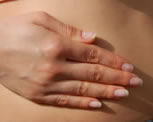Pubic Symphysis Disorder & Diastasis Symphysis Pubis
Pubic Symphysis Disorder effects over 16,000 pregnant women every year in the UK. It refers to altered function and pain of the pubic joint. The pubic joint is formed by the left and right pelvic bones coming together in the middle of the pubic region. Together with the sacro-iliac joints; the pubic symphysis plays an important role in holding the pelvis as a steady ring. During pregnancy, increased levels of relaxin, a hormone produced to allow the pelvis to expand and permit easier passage of the baby, can also de-stabilise the pelvic ring - leaving it vulnerable to excess strain from activity of the legs. The resultant pain can vary from a mild ache to acute immobilising pain. The symptoms can be mistaken for a urinary tract infection.
 Diastasis Symphysis Pubis means an abnormally wide gap of 1cm or more between the two pubic bones. There can also be a slight misalignment which is diagnosed by an Xray (flamingo stance), ultrasound or MRI. The joint can take 3-5 months to return to a normal state.
Diastasis Symphysis Pubis means an abnormally wide gap of 1cm or more between the two pubic bones. There can also be a slight misalignment which is diagnosed by an Xray (flamingo stance), ultrasound or MRI. The joint can take 3-5 months to return to a normal state.
Signs of Pubic Symphysis Disorder:
- Pain and tenderness over the pubic symphysis, inner thigh, groin and lower abdomen.
- Waddling gait with difficulty in climbing stairs and turning in bed.
- Aggravated by weight bearing, separating legs, getting in and out of cars.
How Osteopathy can help with Pubic Symphysis Pain:
Osteopaths take a detailed case history of your current concerns, medical & family history. Osteopaths have a sound knowledge of medicine and are able to identify possible underlying health problems that may exist in addition to your presenting problem. The Osteopath will examine your posture and area of pain, for which you may need to remove the outer layers of clothing. Once a diagnosis is formulated and explained, treatment commences. Osteopathic treatment is non-invasive, gentle, safe and generally pain-free & consists of a variety of combined gentle and safe techniques, including:
- Spinal manipulation
- Cranio-sacral osteopathy
- Soft tissue massage
- Mobilisation
- Myo-fascial dry needling
- Postural and ergonomic support
- Specific exercises and stretches.
By addressing the pain and altered function of the pubic joint early in its development, further strain and possible separation of the pubic joint can be avoided. Ongoing treatment is often required through the pregnancy to help the pelvis adjust to the changing postural demands of the growing baby.
There is often a history of a ankle sprain, knee injury or road traffic accident predisposing the onset of pubic symphysis disorder. The changing shape and increasing weight during pregnancy places new and further demands on the body at a time where hormonal ligamentous laxity reduces the bodies ability to hold joints together. For this reason, pregnant women find that old injuries can again become active. In the case of Pubic Symphysis Disorder, often, there is reduced mobility in the mid-spine and the sacro-iliac joints forcing the axis of mobility through an otherwise static and stable joint – giving rise to pain. Osteopaths help prevent load being placed through the pubic symphysis and ensuring that all interconnected muscles and joints are moving freely.
Osteopathic treatment will also work on reducing muscle spasm and easing the strain of the pubic joint ligaments. Exercise and support aid will also be discussed with you to ease the symptoms
Advice on coping with Pubic Symphysis Disorder:
- Listen to your body – if it hurts don’t do it!
- Accept assistance – this is not a sign of weakness.
- Avoid straddling movements – keep knees and inner thighs ‘glued’ together when changing position such as getting out of a car.
- Maintain symmetry when moving, sitting & standing. Avoid crossing your legs and attempt to stand with your weight equally distributed between both feet. Similarly, sit evenly on both buttocks.
- Brace your abdominal and pelvic muscles when you bend and lift. You may also find it helpful to hold your lower abdomen whilst walking.
- Try to avoid upper body twists, squatting & heavy lifting – i.e. avoid any activity that might put more strain on your pelvis.
- Place a pillow between your knees at night.
- Be careful not to slip.
- Rest regularly.
- Take smaller steps – walking sideways can sometime feel easier when acute.
- Your baby is not affected by pelvic dysfunction.
- Breastfeeding does not interfere with pelvic dysfunction – there are different hormones at play.
- Aids are often very helpful, such as crutches, wheel chair, a claw to pick things off the floor, using a perching stool and a bathboard to prevent you stepping in and out of the bath.
- Pelvic support: A trochanteric belt, tubigrip (size K or L) or sacro-iliac belt will provide support and ease the pain
- Swimming will help strengthen the pelvic muscles but avoid breast stroke.
- Ensure that you are always wearing good shoes. Avoid flat shoes without arch support, similarly avoid heels.
- Pelvic dysfunction can also be aggravated by synthetic hormonal intervention such as the contraceptive pill and HRT, particularly if they are progesterone based.
How to manage labour with Pubic Symphysis Disorder:
- Measure the comfortable range of separating your knees without pain. Let your midwife and obstetrician know so that they can ensure your knees are not parted further even with an epidural.
- The best position that places least strain on the pubic symphysis is lying on your side with someone supporting your upper leg or kneeling upright.
- Speak to your obstetrician about the benefits against the possible complications of caesarean delivery.